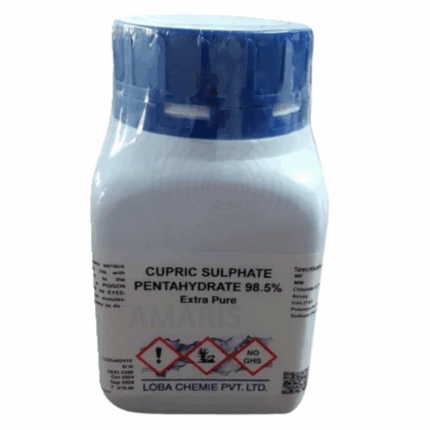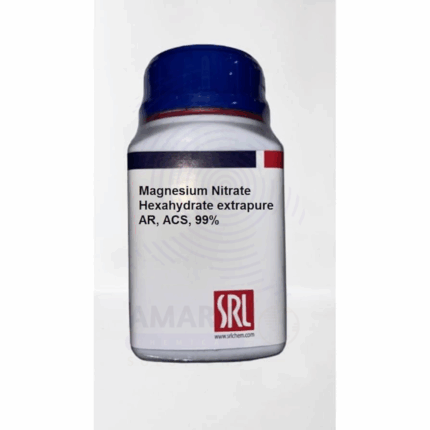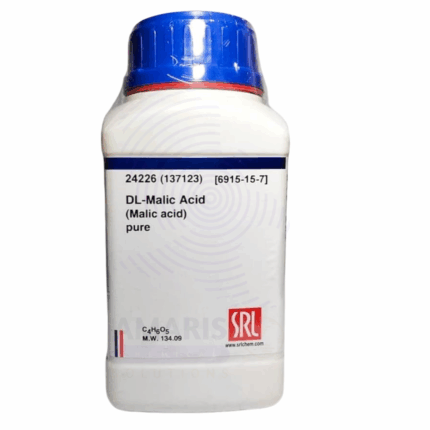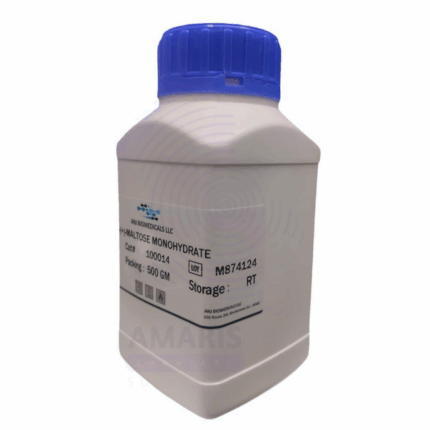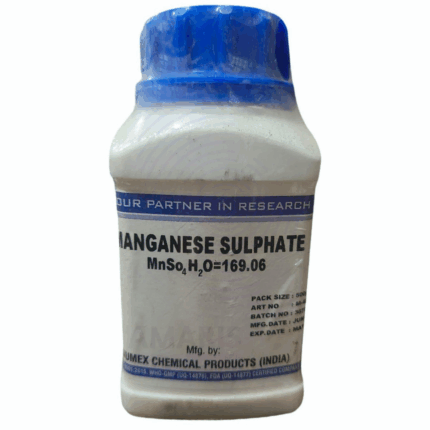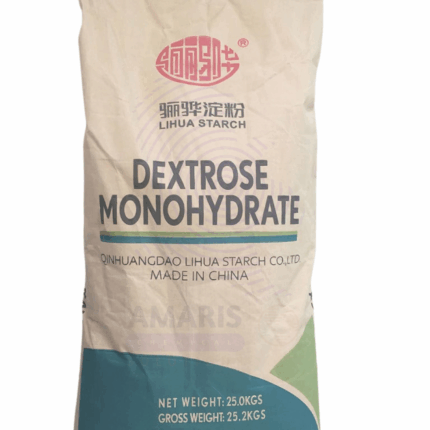
Methyl Orange Solutions Extra Pure
$ 14.85 Original price was: $ 14.85.$ 14.78Current price is: $ 14.78.
Methyl Orange Solutions Extra Pure is a ready-to-use, high-grade pH indicator solution widely utilized in acid-base titrations and general analytical chemistry. Known for its distinct and sharp color transition—from red in acidic environments to yellow in alkaline conditions—it provides rapid and clear visual cues for end-point detection. This extra pure formulation ensures maximum accuracy, reliability, and reproducibility in laboratory settings. It is especially effective in titrations involving strong acids and weak bases, commonly used in educational, research, and industrial labs. The solution is precisely prepared to standardized concentrations, eliminating the need for dilution or mixing, and is ideal for professionals seeking precision and ease of use.
Methyl Orange Solutions Extra Pure
Primary Uses
- pH Indicator in Acid-Base Titrations – Pre-prepared solution used for quick, accurate titration in laboratories; shifts from red (pH < 3.1) to yellow (pH > 4.4).
- Analytical Chemistry – Ideal for precise, reproducible acidity measurements in research, industrial labs, and quality control settings.
Secondary Uses
- Teaching Aid – Used in classrooms and teaching labs to visually demonstrate pH changes and titration techniques.
- Visual pH Range Testing – Sometimes used in field kits or for rough pH estimation where high accuracy is not required.
- Colorimetric Analysis – Serves as a standard for colorimetric testing in certain qualitative analysis setups.
| PACK SIZE |
500ml |
|---|
1. Basic Identification Attributes
- Chemical Name: Methyl Orange Solution
- Synonyms: Methyl Orange Indicator Solution
- CAS Number: 547-58-0 (for methyl orange solute)
- Molecular Formula (solute): C₁₄H₁₄N₃NaO₃S
- Molecular Weight (solute): 327.33 g/mol
- Appearance: Orange-red solution
- Odor: Odorless or mild solvent-like (depending on solvent base: typically water or ethanol)
- Solubility: Fully soluble in water and ethanol
- Grade: Extra Pure
- pH Indicator Range: 3.1 (red) to 4.4 (yellow)
2. Safety & Hazard Attributes
- GHS Classification:
- May vary based on solvent (usually non-hazardous if aqueous)
- If ethanol-based: Flammable liquid (Category 2), eye irritant (Category 2A)
- Hazard Statements (aqueous):
- May cause eye or skin irritation in concentrated form
- Avoid inhalation of mist
- Hazard Statements (ethanol-based, if applicable):
- H225: Highly flammable liquid and vapor
- H319: Causes serious eye irritation
- Precautionary Statements:
- P280: Wear protective gloves/eye protection
- P210 (if flammable solvent): Keep away from heat/sparks/open flames
- P305+P351+P338: IF IN EYES: Rinse cautiously with water
- Personal Protective Equipment (PPE):
- Gloves
- Lab coat
- Safety goggles
- First Aid Measures:
- Inhalation: Move to fresh air if mist inhaled
- Skin Contact: Wash with soap and water
- Eye Contact: Rinse with water for several minutes
- Ingestion: Rinse mouth; not intended for ingestion
- Fire Hazards:
- Aqueous: Non-flammable
- Ethanol-based: Flammable – use foam, CO₂, or dry chemical extinguishers
3. Storage & Handling Attributes
- Storage Conditions:
- Store tightly closed in amber bottle
- Keep away from heat and light
- Store below 25 °C in a well-ventilated area
- Handling Tips:
- Use dropper or dispenser to minimize contamination
- Avoid contact with clothing and skin
4. Laboratory Applications
- Primary Uses:
- Acid-base indicator in titration (e.g., strong acid vs. weak base)
- Colorimetric analysis and endpoint detection
- Secondary Uses:
- Educational demonstrations in chemistry labs
- Reference standard in analytical methods
SAFETY PRECAUTIONS
Personal Protective Equipment (PPE):
- Wear a lab coat, nitrile gloves, and protective goggles.
- Use in a well-ventilated area or under a fume hood.
Handling:
- Avoid contact with skin, eyes, and clothing.
- Do not breathe vapors or mists.
- Wash hands thoroughly after use.
Storage:
- Store in a cool, dry, and well-ventilated area.
- Keep the container tightly closed and away from light and heat sources.
- Avoid contact with strong oxidizing agents.
FIRST AID MEASURES
Inhalation:
- Remove to fresh air immediately.
- Seek medical attention if breathing becomes difficult.
Skin Contact:
- Wash affected areas with soap and plenty of water.
- Remove contaminated clothing.
- Seek medical attention if irritation persists.
Eye Contact:
- Rinse cautiously with water for several minutes.
- Remove contact lenses if present and easy to do.
- Continue rinsing and seek medical advice if needed.
Ingestion:
- Rinse your mouth with plenty of water.
- Do not induce vomiting.
- Seek medical assistance immediately.
FIRE FIGHTING MEASURES
Flammability:
- Non-flammable under normal conditions, but may burn at high temperatures.
Extinguishing Media:
- Use water spray, CO₂, dry chemical, or foam.
Hazardous Combustion Products:
- May emit carbon oxides and nitrogen oxides when burned.
Firefighter Protection:
- Wear self-contained breathing apparatus (SCBA) and full protective clothing.


 Preservatives(food)
Preservatives(food) Flavor Enhancers
Flavor Enhancers Acidulants
Acidulants Sweeteners
Sweeteners Antioxidants
Antioxidants Colorants(food)
Colorants(food) Nutraceutical Ingredients (food)
Nutraceutical Ingredients (food) Nutrient Supplements
Nutrient Supplements Emulsifiers
Emulsifiers
 Collectors
Collectors Dust Suppressants
Dust Suppressants Explosives and Blasting Agents
Explosives and Blasting Agents Flocculants and Coagulants
Flocculants and Coagulants Frothers
Frothers Leaching Agents
Leaching Agents pH Modifiers
pH Modifiers Precious Metal Extraction Agents
Precious Metal Extraction Agents
 Antioxidants(plastic)
Antioxidants(plastic) Colorants (Pigments, Dyes)
Colorants (Pigments, Dyes) Fillers and Reinforcements
Fillers and Reinforcements Flame Retardants
Flame Retardants Monomers
Monomers Plasticizers
Plasticizers Polymerization Initiators
Polymerization Initiators Stabilizers (UV, Heat)
Stabilizers (UV, Heat)
 Antifoaming Agents
Antifoaming Agents Chelating Agents
Chelating Agents Coagulants and Flocculants
Coagulants and Flocculants Corrosion Inhibitors
Corrosion Inhibitors Disinfectants and Biocides
Disinfectants and Biocides Oxidizing Agents
Oxidizing Agents pH Adjusters
pH Adjusters Scale Inhibitors( water)
Scale Inhibitors( water)
 Antioxidants(cosmetic)
Antioxidants(cosmetic) Emollients
Emollients Fragrances and Essential Oils
Fragrances and Essential Oils Humectants
Humectants Preservatives
Preservatives Surfactants(cosmetic)
Surfactants(cosmetic) Thickeners
Thickeners UV Filters
UV Filters
 Fertilizers
Fertilizers Soil Conditioners
Soil Conditioners Plant Growth Regulators
Plant Growth Regulators Animal Feed Additives
Animal Feed Additives Biostimulants
Biostimulants Pesticides (Herbicides, Insecticides, Fungicides)
Pesticides (Herbicides, Insecticides, Fungicides)
 Active Pharmaceutical Ingredients (APIs)
Active Pharmaceutical Ingredients (APIs) Excipients
Excipients Solvents(pharmaceutical)
Solvents(pharmaceutical) Antibiotics
Antibiotics Antiseptics and Disinfectants
Antiseptics and Disinfectants Vaccine Adjuvants
Vaccine Adjuvants Nutraceutical Ingredients (pharmaceutical)
Nutraceutical Ingredients (pharmaceutical) Analgesics & Antipyretics
Analgesics & Antipyretics
 Analytical Reagents
Analytical Reagents Solvents(lab)
Solvents(lab) Chromatography Chemicals
Chromatography Chemicals Spectroscopy Reagents
Spectroscopy Reagents microbiology-and-cell-culture-reagents
microbiology-and-cell-culture-reagents Molecular Biology Reagents
Molecular Biology Reagents Biochemical Reagents
Biochemical Reagents Inorganic and Organic Standards
Inorganic and Organic Standards Laboratory Safety Chemicals
Laboratory Safety Chemicals Specialty Laboratory Chemicals(Special Laboratory Equipment)
Specialty Laboratory Chemicals(Special Laboratory Equipment)
 Demulsifiers
Demulsifiers Hydraulic Fracturing Fluids
Hydraulic Fracturing Fluids Scale Inhibitors(oil)
Scale Inhibitors(oil) Surfactants(oil)
Surfactants(oil) Drilling Fluids
Drilling Fluids
 Dyes and Pigments
Dyes and Pigments Bleaching Agents
Bleaching Agents Softening Agents
Softening Agents Finishing Agents
Finishing Agents Antistatic Agents
Antistatic Agents
 Admixtures
Admixtures Waterproofing Agents
Waterproofing Agents Sealants and Adhesives
Sealants and Adhesives Curing Compounds
Curing Compounds Concrete Repair Chemicals
Concrete Repair Chemicals Anti-Corrosion Coatings
Anti-Corrosion Coatings
 Surfactants(cleaning)
Surfactants(cleaning) Builders
Builders Enzymes
Enzymes Solvents (Cleaning)
Solvents (Cleaning) Fragrances
Fragrances
 Electronic Chemicals
Electronic Chemicals Catalysts
Catalysts Lubricants
Lubricants Photographic Chemicals
Photographic Chemicals Refrigerants
Refrigerants Automotive chemicals
Automotive chemicals Pyrotechnic Chemicals
Pyrotechnic Chemicals
 Biodegradable Surfactants
Biodegradable Surfactants Bio-based Solvents
Bio-based Solvents Renewable Polymers
Renewable Polymers Carbon Capture Chemicals
Carbon Capture Chemicals Wastewater Treatment Chemicals
Wastewater Treatment Chemicals
 Pigments
Pigments Solvents(paint)
Solvents(paint) Specialty Coatings
Specialty Coatings Binders/Resins
Binders/Resins Additives
Additives Driers
Driers Anti-Corrosion Agents
Anti-Corrosion Agents Functional Coatings
Functional Coatings Application-Specific Coatings
Application-Specific Coatings
 Fresh Herbs
Fresh Herbs Ground Spices
Ground Spices Whole Spices
Whole Spices Spice Blends
Spice Blends Dried Herbs
Dried Herbs
 Leavening Agents
Leavening Agents Dough Conditioners
Dough Conditioners Flour Treatments
Flour Treatments Fat Replacers
Fat Replacers Decoratives
Decoratives Preservatives(baking)
Preservatives(baking)
 Plasticizers & Softeners
Plasticizers & Softeners Reinforcing Agents
Reinforcing Agents Adhesion Promoters
Adhesion Promoters Vulcanizing Agents
Vulcanizing Agents Antidegradants
Antidegradants Blowing Agents
Blowing Agents Fillers & Extenders
Fillers & Extenders Accelerators & Retarders
Accelerators & Retarders


